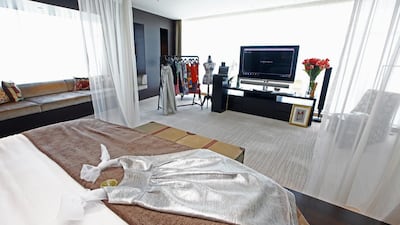DUBAI // Google transformed two floors of a Dubai hotel into its "Google House" – complete with its ubiquitous beanbags, liberal use of pastel colours, and bizarre technology – to show how its stable of apps and gadgets could possibly improve our homes.
From using voice commands on your tablet to call up recipes while cooking, using Google Glass to navigate around the city and even Google Trends to identify the most popular styles in fashion while getting dressed, the company hoped to demonstrate it had a piece of tech for pretty much everything.
Michael Valvo, manager of communications at Google, said the intention of the house set up at the JW Marquis hotel on Sheikh Zayed Road was not to show a home of the future, as much as improving a home of now.
“The future is in our pocket right now. We wanted to showcase all these scenarios in everyday life where you can use all the smartphone functions people might not be immediately aware of.”
The Google House was split over five rooms: kitchen, living room, study, travel room and “fashion room”, with a sixth set aside for visitors to try out Google Glass, the company’s latest wearable tech.
The headset displayed information about your surroundings via a small screen at eye level, although trying to use it while walking felt like an invitation for an accident.
The technology was operated by both voice control and a swipe application on the side of the headset.
The voice function was not always the most responsive and gave a literal definition of the word “temperature” when asked what the temperature was.
A Google host explained that speaking to the device, much like being able to wear it in daily life, was an acquired skill.
“You get used to it and after a while forget it’s even there,” said the host, who added she wore the device for 80 per cent of her day.
Aside from Google Glass, the majority of technology on offer was smartphone-based, linked up to huge displays dotted around the home via Wi-Fi. It did not include any actual home appliances the company is working on, such as Nest Labs’ “learning thermostat”.
Earlier this year, Google paid US$3.2 billion (Dh11.7bn) to buy Nest Labs and its appliance that controlled the temperature of a home based on user habits – such as when they get up or arrive home from work – or how hot or cold it was outside.
It was the first inroads the company had made into people’s homes, but that could increase in the near future, said Mr Valvo.
“In the kitchen we’ve seen people using a tablet or phone,” he said. “Maybe one day you’ll be able to ask the fridge the same questions you’re currently asking your phone. You shouldn’t be limited to where you are.
“Technology needs to work around you. If you’re in the car, at home or in the office.”
The Google House did show some unique applications, ranging from the practical to the niche.
They included being able to plan your day’s journey using Google Nav, checking the location of the nearest petrol station or grocery on Google voice search, while in the fashion room a “Googler” explained how the Trends app could help you identify what was fashionable or not before stepping out.
“I’ve been reading all these magazines about different forms of eye make up, from smokey eyes, to blue eyeliner, to hooded eyes, and so on,” said a Google host. “It’s still difficult to know what’s hot and what’s not.”
A highlight was a demonstration by celebrity chef Osama Atyab who used Google voice search to help him find the recipe for sponge cake.
“So far, it doesn’t cook,” he said. “But it seems to be able to do anything else.”
mcroucher@thenational.ae

